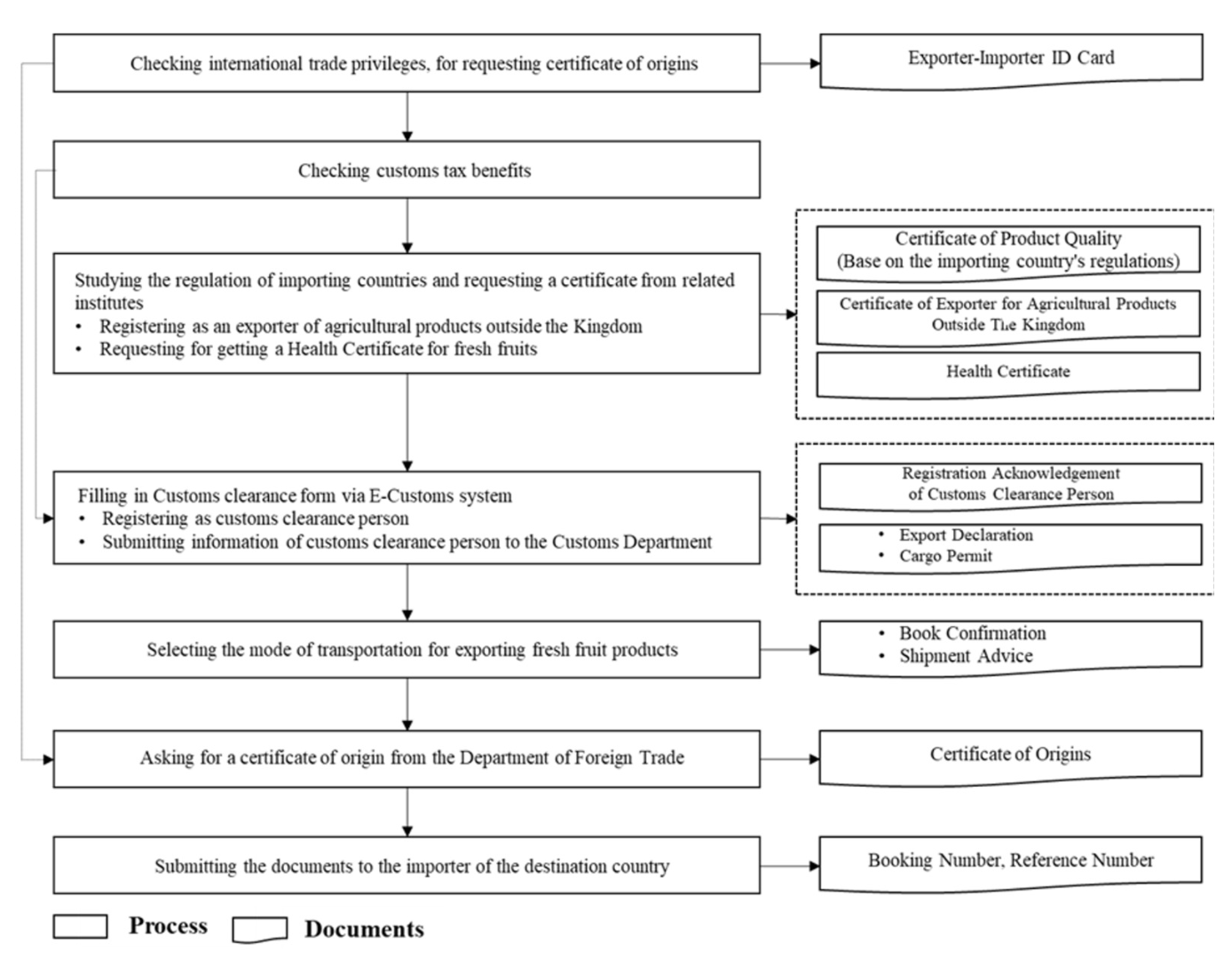Development of Exporting Fresh Fruits Ontology for Improving the Knowledge-Based System on the Domain of Export Process in Thailand
Main Article Content
Abstract
Thailand's exports are crucial to the country's economic income, with agricultural products among the most important. Import-export firms mainly manage the export process because agriculturists hesitate to deal with complex procedures. Based on the complex procedures and lack of knowledge about the export process, new entrepreneurs and agriculturists often struggle to export their products directly. Therefore, a simplied system is needed for those seeking information on export procedures. To address this, the Exporting Fresh Fruits Ontology was developed to en- hance the knowledge-based system for managing fresh fruit exports. This system involves three main steps: reviewing export processes and documents, generating ontology for the fresh fruit export domain, and developing the knowledge-based system. The Hozo Ontology Editor is the system's backbone, built using the Ontology-based Application Management (OAM) framework. The Exporting Fresh Fruits Ontology comprises 12 main classes, sub-classes, and attributes, capturing knowledge of the export process. It includes mappings between relational database entities and the ontology, capturing semantic information, and validating mapping consistency to eliminate errors. The results show that the Exporting Fresh Fruits Ontology performs well, achieving an average F-measure value of 0.98.
Article Details

This work is licensed under a Creative Commons Attribution-NonCommercial-NoDerivatives 4.0 International License.
References
Department of International Trade Promotion, “The exporting process of vegetable and
fresh fruits; OSEC,” 2023. [Online]. Available: https://onestopservice.ditp.go.th/exportlist/26.
R. Mizoguchi, “Part 1: Introduction to ontological engineering,” New generation computing, vol.21, pp. 365-384, 2003.
T. Berners-Lee, J. Hendler and O. Lassila, “The semantic web. Scientific American: A new form of Web content that is meaningful to computers will unleash a revolution of new possibilities,” Scientific American, vol. 284, no. 5, pp. 1-4, 2001.
D. L. McGuinness and F. Van Harmelen, “OWL web ontology language overview;
W3C recommendation,” 2023. [Online]. Available: https://www.w3.org/TR/2004/REC-owl-features-20040210/$sharp$s1.
L. W. Lacy, “OWL: Representing information using the web ontology language,” in Ontologies Enablers of the Semantic Web, Trafford Publishing, 2005, pp. 25-42.
D. L. McGuinness, “Ontologies Come of Age,” Spinning the Semantic Web: Bringing the World Wide Web to Its Full Potential, MIT Press. pp. 1341-1931, 2005.
A. Takhom, M. Ikeda, B. Suntisrivaraporn and T. Supnithi, “Toward Collaborative LCA Ontology Development: A Scenario-Based Recommender System for Environmental Data Qualification,” in 29th International Conference on Information for Environmental Protection (EnviroInfo 2015) Third International Conference on ICT for Sustainability (ICT4S 2015), Copenhagen, Denmark, Atlantis Press, pp. 157-164, 2015.
M. Buranarach et al., “A community-driven approach to development of an ontology-based application management framework,” Semantic Technology, Springer Berlin Heidelberg, Berlin, pp. 306–312, 2013.
A. Onal, S. Otles and I. Seylan, “A Concept Distance Leaning Architecture using Semantic Web based Multi-Agent System,” Logfurum, vol. 3,no. 1, pp. 1-8, 2007.
B. Marut et al., “OAM: an ontology application management framework for simplifying
ontology-based semantic web application development. OAM: an ontology application management framework for simplifying ontology-based semantic web application development,” International Journal of Software Engineering and Knowledge Engineering, vol. 26, no. 1, pp. 115-145, 2016.
W. Bangkhomned and J. Payakpate, “Applying Ontology Knowledge Representation Technology and Semantic Searching Methods to Support the Production of High Quality Longan Fruit,” in Information Science and Applications: ICISA 2019, Springer Singapore, pp. 601-612, 2020.
Control Device Division, Enegate Co, ltd. Mizoguchi Laboratory, The Institute of Scientific and Industrial Research, Osaka University. 2011, Hozo Ontology Editor (Distributed Development Version) Operating Manual.
P. Taophan and P. Meesad, “An Ontological Content-Based Filtering for Book Recommendation,” International Journal of the Computer, the Internet and Management, vol. 25, no. 1, pp. 75-82, 2017.
N. Kaewboonma, T. Supnithi and J. Panawong, “Developing ontology for Thai Zingiber aceae: From taxonomies to ontologies,” 2017 14th International Conference on Electrical Engineering/Electronics, Computer, Telecommunications and Information Technology (ECTI-CON), Phuket, Thailand, pp. 596-599, 2017.
P. Visutsak, “Ontology-Based Semantic Retrieval for Durian Pests and Diseases Control System,” International Journal of Machine Leaning and Computing, vol. 1, no. 11, pp. 92-96, 2021.
N. Rastogi, P. Verma and P. Kumar, “Evaluation of Information Retrieval Performance Metrics using Real Estate Ontology,” 2020 Third International Conference on Smart Systems and Inventive Technology (ICSSIT), Tirunelveli, India, pp. 102-106, 2020.
P. Visutsak, “Ontology-based semantic retrieval for durian pests and diseases control system,” International Journal of Machine Learning and Computing, vol. 11, no.1, pp.92-97, 2021.
A. Islam and D. Inkpen, “Semantic Text Similarity Using Corpus-Based Word Similarity
and String Similarity,” ACM Transactions on Knowledge Discovery from Data, vol. 2, no. 2:10, pp. 1-25, 2008.
N. F. Noy and D. L. McGuinness, “Ontology development 101: A guide to creating your first ontology,” Semantic Scholar, pp. 1-25, 2001.
P. Wiangnak and A. Trongratsameethong, “Automated Knowledge Integration from Heterogeneous Data Sources Using Text Analytics: A Case Study of COVID-19,” ECTI Transactions on Computer and Information Technology (ECTI-CIT), vol. 17, no. 4, pp. 533-543, 2023.


